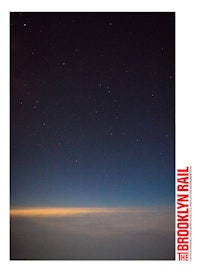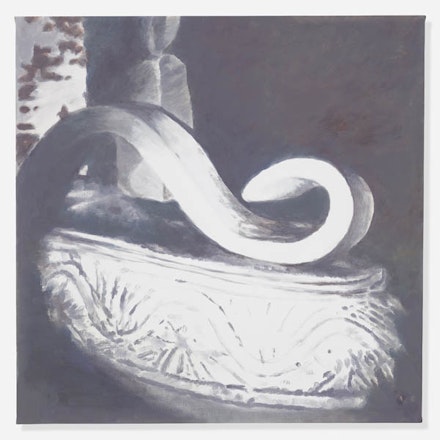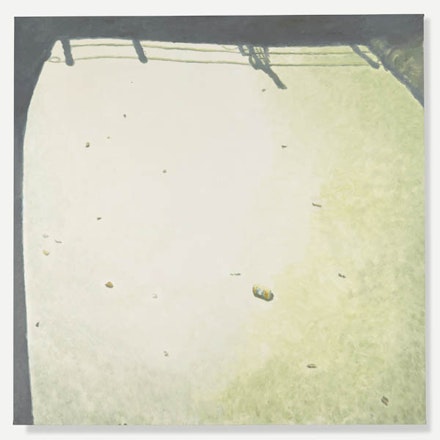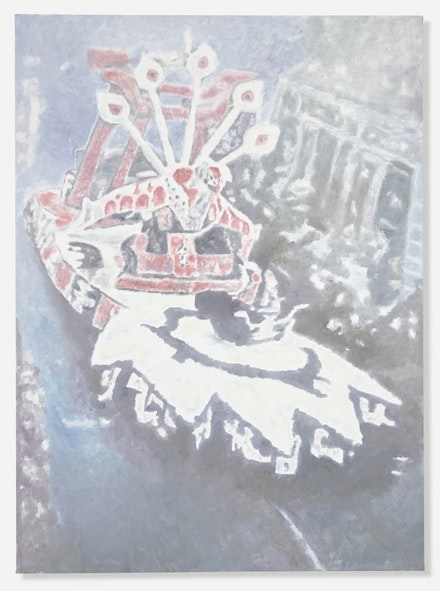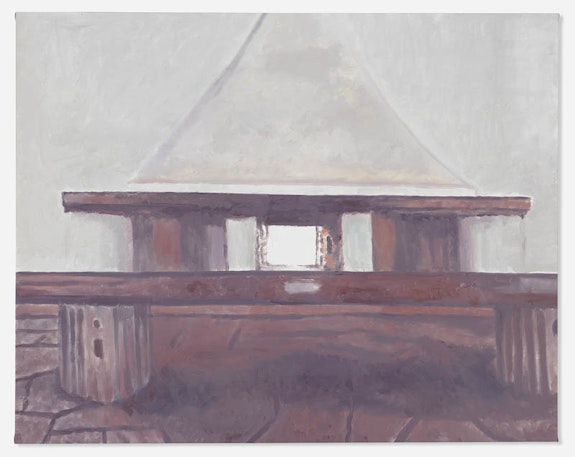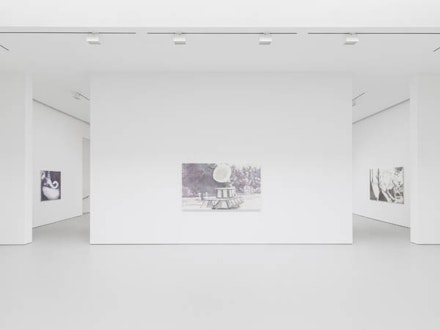Art In Conversation
LUC TUYMANS with Jarrett Earnest
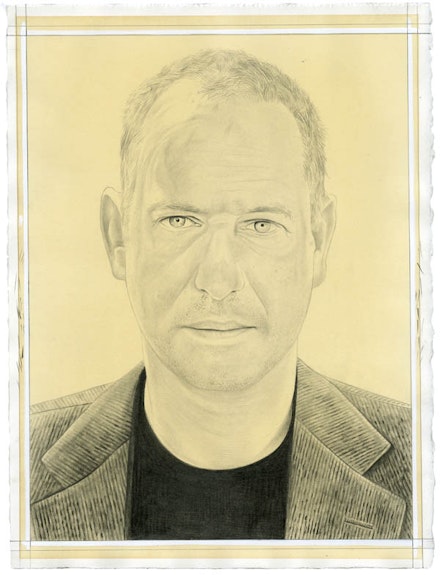
For decades, Luc Tuymans’s paintings have plumbed the nature of images—charting the limits of their personal and political functions. Before the opening of his latest solo show at David Zwirner Gallery, Tuymans spoke with Jarrett Earnest about temperature in paintings, their instantaneous decay, and the balance between violence and tenderness.
Jarrett Earnest (Rail): I wanted to start by talking about color. In this exhibition the painting Model (2015), appears to be a single dark tone, but within it there is a subtle fluctuation between warm and cool, which creates a very gentle rocking across the surface of the painting.
Luc Tuymans: That is true. First of all, I don’t use black. That is important to know. I used to use a lot of van Dyck brown to get this really deep, dark color. I do that because it’s about the profoundness, the depth of the tone, which, if you use black and just mix it with white, will be flat. Therefore you’re right; in Model there are two different colors, it has been worked twice: first in the cool color, then overworked again the same day with a brown because it was too blue. When there was just one color it stuck out too much; it was not the right balance with the image.
Rail: That painting showed me something about the rest of the show, which is that they have a color dynamic that wavers between warm and cool contrasts, that are very close in tone. In the three “Murky Water” paintings (2015) I was particularly interested that they are green, which is already a mixture of warm and cool—blue and yellow. Its relationship to warm and cool is precarious, so that the rather cool green feels warm next to a blue-edged shadow. How do you approach the color temperature as structure?
Tuymans: The temperature of things is really important. The early works, particularly the Gaskamer [Gas Chamber] (1986), are quite warm in temperature. Throughout the years I’ve become much more cool. There is a big difference between the “Corso”flower parade paintings and the green “Murky Water”paintings—they are from different distances. They are differently painted also. That was the whole idea, to let them collide with each other, which gave me the idea of the title for the show—Le Mépris [Contempt (1963)], the same as Godard’s film. The title painting in the exhibition, which shows the fireplace of that fantastic villa where Godard filmed is the only painting in the show that deals not with temperature but with light: light that beams out—pierces, actually—and makes a hole in the wall. In producing a show there is one particular painting I make to stop it, put the lid on the body of work, and that was it.
Rail: One of the special things that color can do in painting is create light.
Tuymans: That is why I always work with tonality. It’s nice to see this show in the early afternoon, like today, with this gray light that is very luminescent; you can see much better how it’s put together. That sensibility, that light, is very particular to the region of artists I come from, there is much more tonality. I actually curated a show of Belgian abstract art, The Gap, which is still up at the Museum of Modern Art in Antwerp, of people from the ’50s who are largely unknown and made fantastic work—even though they are abstract, they are all related to reality, and that kind of sensibility. There is a specific apprehension of light, which is really important. That is the reason for the persistence in working with this tonality. A lot of people could say that my paintings are monochromatic but, as you correctly saw, they are not, because there is much more investment in creating a certain temperature or tonality than just a color, which is very difficult. And I mix these things. It isn’t premeditated—you put in this color and that color and it is surprising to see which colors you have to put in to get to that tonality, which is not always that self-evident.
Rail: How has your relationship to color changed?
Tuymans: In the beginning I banned it. I actually started out as a very colorful, gestural painter. When I started to work with imagery I wanted to go more for the signifier and what it meant than the aesthetics of it, which meant I had to reduce, and reduce drastically, to a point that some of the works can look pretty graphic. This has changed, of course, because I allow myself more painterly freedom now than I did twenty years ago.
Rail: Godard’s Le Mépris is one of the most perfect films ever made; how do these paintings relate to it?
Tuymans: It’s much more about the idea and the word “contempt.” There are so many elements to that film: you have a mythological element, the Greek sculptures; then you have the tricolore of France, though Godard is Swiss; then you have Curzio Malaparte, the megalomaniac Italian writer who claimed he built that Villa himself—which he didn’t, he had an architect. He’s a very interesting writer—books like Kaputt (1946) are still banned by the Vatican. In the film you can see that Brigitte Bardot understands zilch of it, she’s a total void. You have an epic aspect, and sex, jealously, and of course contempt. The film is loosely based on Alberto Moravia’s Il Disprezzo, which I also read of course, but you don’t really find that many threads in that film. What you do find is a specific space. There is also the element of the festive that goes totally wrong, like an accident. There is despair and decay—decay because the water is polluted and because the floats will immediately perish, they will be scrapped the day after the parade. All that feeling is in Godard, which is atypical of a Godard movie anyhow—it’s even something that escaped him, so to speak, and that is what makes it so fucking important. This type of film will never be made again, it’s a one-off, even for Godard. The end with Jack Palance and Brigitte Bardot crushed by two trucks—fantastic. It becomes indifferent, ungraspable to a point, and that is really an achievement in cinema. Recently there were three films like that in the same year: Control (2007), the biopic about Ian Curtis, which was really good, No Country For Old Men (2007) by the Coen brothers, and then you have There Will Be Blood (2007) by Paul Thomas Anderson—those three films did something which contemporary art has not yet been able to do in terms of sardonic intensity.
Rail: Twenty years ago you wrote the essay “On the Image,” which is an incredible piece of writing and thinking. I wonder how you feel the function of the image has changed since then.
Tuymans: Enormously, I suppose, seeing the tools we have now. I was never a tech guy but when I saw the iPhone touch screen I thought, I want to have that. It changes the way you perceive things, the way you can even crop and distort on your phone. Even if we don’t want to admit to it, it will change our way of looking at things—which is not a problem, it’s just what happens. I’m not going to be an idiot and reject it, why? It’s just another tool and it makes life easier up to a certain point and more complicated at the same time.
Digital technology delivers a different structure of imagery. When I received the Max Beckmann Foundation award at the Städelschule in 2007, I curated an exhibition for the Städel Museum in Frankfurt. They wanted me to go through the collection of five thousand works and create a show, but they also wanted it to have work of mine. I had a diptych, one part of which was in China and the other one was in my studio, that shows a guy shuffling in my garden next to a tree—actually quite like Millet, it could be a 19th-century image. I decided to hang that specific painting, Against the Day (2008), next to a painting by Fernand Khnopff, The Game Warden (1883), which shows a hunter with his gun. The contrast was shocking—the light was totally different, and mine clearly came out of a digital age. My painting had nothing to do with the 19th century even though the imagery was the same, which means every age has a specific quality to it that you will be able to retrace via the visual itself. Against the Day was the first from a large body of work about digitalized imagery.
Rail: One of the things I loved about your essay on the image is that you describe the static image as disappearing as soon as it’s made.
Tuymans: Because it’s in decay. A painting as an object in the world is decaying. It is interesting doing a show where you get works back from thirty years ago, and you see that they are aging—the colors are deepening or yellowing—even though they’re in fairly good shape. Some of these paintings traveled a lot and there is a weariness in the paintings, like they are tired, and in a way it deepens them. When you get to put recent work next to old work you can see how they function—and they do function, no problem—but they are very different experiences.
Rail: One of the reasons I’m interested in color is because it is the least stable part of an image—the colors change at different rates and for different reasons. I’ve started to think of color as always temporal—a blooming flower—color as a rupture and movement through time. You can also move through paintings because of color.
Tuymans: If you see the first flower float painting in the show, you’ll see there is a darkened area of the flowers—more contrast and a different depth. This is what you can do with tonality and color: you pick the point where it breaks and that is the entry. Van Eyck is so perfect, everything is so held down, and maybe he’s the only one that gets away with it, which is why he’s a real motherfucker. I’ve often said that after van Eyck we’re all dilettantes. In that sense, there has to be something off-balance, which is the point where you get into the image. That is really important with static imagery because that is the point where it moves.
Rail: You’ve said that one distinction between painting and photography is that people can remember a photograph better than a painting, but that painting loosens an emotional dimension.
Tuymans: Painting is far more detailed. It’s more physical, and therefore very difficult to remember.
Rail: Where does that put photographs of paintings?
Tuymans: A good painting is a bad painting in a photograph. Whenever your paintings look better in reproduction you should get scared because something’s wrong. The reproduction should remain the reproduction. That is a totally different ball game, and that is why I still paint.
Rail: I’m interested in the places where you’ve gestured toward painting’s emotional function. How do you see the relationship between emotion and form?
Tuymans: It is rather collateral damage, accidental to a point. A couple of days before the show opened, the first batch of collectors arrived and one elderly woman burst out crying in front of the paintings and came up to me saying they’re so beautiful, and I’m like really? I’m not like Rothko who wanted people to cry in front of his paintings. But they do that—they danced in front of the paintings at the Wexner, they sang in front of them—all totally ridiculous. That may be too harsh: it’s beautiful and nice, but it’s not true. It can’t be true, it’s an image. So the emotion is really an element of perversion, and it’s also a construction of culture. Torture comes from tenderness. The balance between violence and tenderness is the most efficient way to torture anything or anybody. That’s what it’s about and I’ve clearly been into that power game from the start—my imagery is clearly built on an interest in that power.
But I cannot devoid myself from the fact that whenever I finish a painting I’m still amazed that it worked—there is a magical moment. What is unexplainable, even to me—and I’ve been working at this for more that thirty-five years so I know all the tricks—is that I’m still very nervous when I start, not totally secure. By the middle of the painting the security comes in because it starts to work, and then the total amazement when you stop, because something has left your body, has become a total entity in opposition to what you are, because it’s an image. In the studio they mostly hang tacked and un-stretched on the wall, then they get put on stretcher bars. When they are not on stretchers you see much more. When they are stretched you see less—it becomes more diffused, it becomes an object, gets a width—it’s really weird, like a different skin that comes over it. That is always an important point because that is when you see how it really works.
Rail: It makes me think of something Fassbinder said in an interview: “The theme of my films has remained the same, and always will: the manipulability, the exploitability of feelings within the system that we live in.”
Tuymans: Well, he enacted that with the actors in his group, he really abused them. Of course he is also a genius filmmaker, an amazing character.
Rail: In an interview with Juan Vicente Aliaga, you said: “Violence is the only structure underlying my work.” I wanted to know more about that, because you never represent an actual act of violence.
Tuymans: Fritz Lang didn’t show violence; in The Big Heat (1953)you hear the scream, you see the coffee pot, you make a deduction. The same with M (1931), you see the balloon pop and you know the kid dies. The best way to represent violence is not to show it. That is one thing.
With violence as a structure, as an idea: if you take happiness as anthem, what are you going to paint? There is no fucking consequence to any form of happiness. You’re going to be happy for what, thirty seconds, then what? There are many more consequences with violence— there is psychological violence, physical violence, and all types of violence and abuse that create images. I’m constantly looking at those ISIS videos of people dressed in orange jumpsuits about to be decapitated: what are you going to do with that? I went through and saw the whole decapitation—to see a whole decapitation is something completely different, because it’s really horrific. Are you going to paint that? You can’t. It doesn’t have the same function. Of course there have been many depictions, the best being the Caravaggio’s self-portrait David with the Head of Goliath (1610), which is after the beheading.
Rail: In arguments around violent images there is one side that believes those kinds of images proliferate violence, and another that believes it is important to show exactly what happened as a way of confronting the reality of the violence. How do you relate to that discussion?
Tuymans: It is still ambiguous and remains problematic, because I don’t think it will solve anything to decide either way. The repetition of these images is obviously propaganda. It’s terror, but it’s also like a Hollywood production—these guys have good equipment, good lights, and that makes you wonder. In a sense, the premeditation of the production is itself part of its violence. I’m more interested in the moment before or after than the act itself, because I think these things are much more evocative. They are positions, like borders and frontiers, and when they are connected with other imagery they are bound to influence each other.
Rail: When you talk about the influence of film on your paintings, it is mostly through the grammar of cinematic language. But thinking of Hans-Jürgen Syberberg’s Hitler, A Film from Germany (1977), the scrims with rear-projections, cutouts, manikins, and dolls all seem to relate to imagery and effects of your early paintings.
Tuymans: It was a really big shock when I saw that movie in 1978. I first saw Hitler at my parents’ and they still had a black-and-white television. I saw it over two nights, so my reception of the film was black-and-white, not color, and it was far later that I saw the film in color, which is totally different—less cinematic in a weird way, and less epic, because the black and white adds an epic quality. But still, even that way it was a masterpiece. What is interesting is the way that Syberberg seeks to identify with Hitler, and that he goes at it through culture, which is really important because the big difference between German and Italian fascism in general is that German fascism was culture—the culture of Hitler was the first European project. What Syberberg was actually showing was that the Nazis destroyed a great deal of their culture, and they didn’t understand. This was very important because it was exactly the way I was going at it, and he personified that in words as well as imagery.
Rail: One of the best things about right now in painting is that no one is fighting battles between abstraction and representation. When did you feel that change in the discourse around painting?
Tuymans: Well, first of all I came out with my paintings at the exact wrong moment. When I started showing, it was a gallery where they only showed post-conceptual work. Immediately, my paintings weren’t “painting” but were treated like conceptual images, which makes a very big difference. Now there is no need anymore for any of that—modernism, or postmodernism, or post-postmodernism—all those ideas are totally obsolete. Now you can sayit’s relevant or not, but it’s not about fitting art into some theoretical structure. You cannot have October now, which made sense when they did it in the 1980s—that was a different era. Unluckily for the art world, most artists are now isolated by the market. There is a profound need within a generation to find each other, which is more difficult now because there is this specialized mechanism, this art market, and the professionals who are formed there. You end up with discourse like the sociology of the ’80s and misunderstandings of Habermas. So right now there is a grave need for different, intelligent interactions because otherwise art doesn’t really mean much, which is why I’ll probably take some money and do a three-yearly prize on the world level for people who write about art.
Rail: The volume of your writing and interviews ON&BY Luc Tuymans (2013) is very impressive, and I had no idea you’d written so much.
Tuymans: Me neither! And I hate it. I have so much respect for people who write but it’s so difficult, it’s such a slow medium. But moreover, the most important thing in writing is how you formulate things, which is a nightmare for me.
Rail: I assumed you were writing to create a framework to help others understand what you were doing. A lot of the artists I know who are verbally articulate about their work get to a point where they feel imprisoned by the way critics endlessly repeat the terms they’ve set up.
Tuymans: Problematic, but it was my mistake. It was a necessary mistake because when I started out it was all about contextualization—you could not just hang a painting on the wall. You had to say what the source material was, what it meant, etc. Of course the critics loved that because they knew what to write about. Then they all turned on me, Mr. Tuymans you cannot explain it all to us. The damage has been done, but I’m very secure that in time these things will evaporate—I will die and the works will remain, so totally different things will crop up. We’ve already talked about different things today, like color, which is interesting because that is something you can see. It’s important that the visual becomes more central to the discussion.
Rail: The things I was bringing up about your paintings are not just things you can see, but they are the things that you see in person. We have to move toward writing that is more grounded in physical experience.
Tuymans: People are not educated in looking now. They look fast. How long will people stay in front of a painting at a museum, twenty seconds? There are some that really look, but they are the patient people, they look differently. There is a culture of looking that is disappearing because of the fact that you have all these possibilities, overload, and little time to pause.
Rail: You conclude “On the Image” with this thought: “The question is: for and by whom is the information centralized? Who keeps track of it?”
Tuymans: That is what we are living now, and that is the danger. The values have been turned upside-down: what used to be the most valued was the most scarce; what is most valued now is the most accessible thing, but controlling it is the most valued thing. A totally different world.
Rail: One thing about the nature of looking today is that attention itself has been reduced; people have trouble paying attention for long periods of time, so to paraphrase your question, I’ve been asking myself: For and by whom is attention being degraded?
Tuymans: Even in the art world, we have the dominance of the corporation, which monopolizes and makes uniform. There is a great need for differentiation; you have to differentiate room for things in the middle, which is now nearly gone. Today you have to look at all this information, and that is not even the work: it doesn’t have to do with whether the work is good or bad; virtually nothing can be done in art now without the fucking packaging. And that is why a lot of artists are opening their apartments, and trying to run spaces, which I support. But that creates another problem, whether it’s too provincial, or too small, too specific, and too nice.We’ll see what happens, maybe one day the bubble will really explode.

